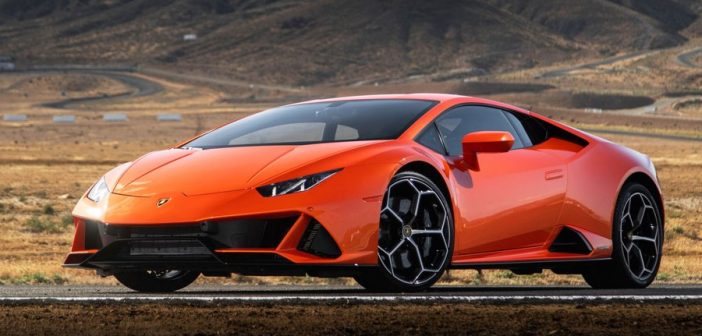Since I’m what would be technically described as an “OK-ish amateur,” it’s a good thing my ride has my back—or, rather, front. The new Lamborghini Huracán EVO I spent a few hours whipping around Willow earlier this month has perhaps the most advanced dynamic control system of any street-legal sports car. It analyzes the vehicle’s status every 20 milliseconds and actually predicts what the driver will do next, setting up the vehicle’s systems to better manage each challenge. So while I’m usually sawing away at the wheel, working to place the car in the best spot along every inch of racetrack, the EVO smooths out that process, making for a less frantic, more enjoyable drive experience.
Ordinarily, every driver assistance system—traction control, stability control, adaptive steering, and so on—has its own computer that responds to inputs from the driver and the other systems. The EVO, a $261,000 enhanced version of the Huracán with 640 horsepower and a 0 to 60 time of 2.9 seconds, pulls all the calculation and control into a single, centralized vehicle dynamics computer. This allows for much faster and more synchronized control over things like wheel braking from the stability control system, the suspension’s responses to track undulations, and the distribution of torque to the wheels. All modern performance cars manage these variables, but this does it particularly well, requiring fewer steering, throttle, and braking corrections from its human.
The result is a system, dubbed Lamborghini Dinamica Veicolo Integrata (LDVI), that produces nearly clairvoyant harmony between driver and machine. For instance, as I head up over the blind, fast, right-hander at turn six, the car gathers data from accelerometers positioned within the EVO’s center-of-gravity, right beneath the console between the seats, as well as my inputs on the pedals and steering wheel. It notes that I hit the brakes quickly and turn sharply, grasping that I’m entering a right turn at speed. It can tell I’m heading uphill on dry pavement and then, as I crest and the suspension goes light as the car lifts, that everything has changed yet again.
All along the way, the computer adjusts the all-wheel-steering’s responsiveness in anticipation of my next move, including pivoting the rear wheels into the turn to help ease the car through. It sets up the suspension’s stiffness as the car lifts, settles, then presses down at the bottom of the hill. It balances torque distribution, stability control, and traction control in the all-wheel-drive system to keep the car aimed in the right direction and securely planted. What would ordinarily be a white-knuckle moment that could cause panic or overcorrection becomes a smooth traversal with nary a hiccup, with the bare minimum of steering inputs necessary for me to sort out where to go on the other side of the hill.
Lamborghini says this system represents not just a technological pivot from how cars typically behave, but a conceptual one. “We’re now able to synchronize the brain of the car with the brain of the driver,” says Maurizio Reggiani, Lamborghini’s chief technology officer.
That can be occasionally disconcerting, though. The new system often sets the car up in a way that you need to adapt to yourself. If I require 20 small corrections to get through a turn because I haven’t learned the racing line or spent much time in a car, the EVO gets me through with 10. So when the car is extending my limits, I have to adapt to that. It only takes a short while to get the hang of it though, and once I start to anticipate those movements, I can work with them to my advantage. And Alessandro Farmeschi, Lamborghini’s CEO of the Americas, assures me the car won’t fight to hold a line if the driver must swerve to get around a crash up ahead. “The processing speed is so fast that all the information from when you see the obstacle is factored into the car’s behavior,” he says.
The LDVI doesn’t use camera feeds or even GPS data to analyze the road ahead, something other cars do primarily with comfort or safety in mind. It surmises your intent based on your actions and the car’s dynamics. “This is really the first of what you might call artificial intelligence in a car,” Reggiani says. “We’re creating a connection between your intention and what the car will do.”
After a day’s worth of hot-lapping Willow Springs in the Huracán EVO, I can attest to that duality—even if anyone watching from the pits only sees me in the driver seat.
–
This article first appeared in www.wired.com
Seeking to build and grow your brand using the force of consumer insight, strategic foresight, creative disruption and technology prowess? Talk to us at +9714 3867728 or mail: info@groupisd.com or visit www.groupisd.com



